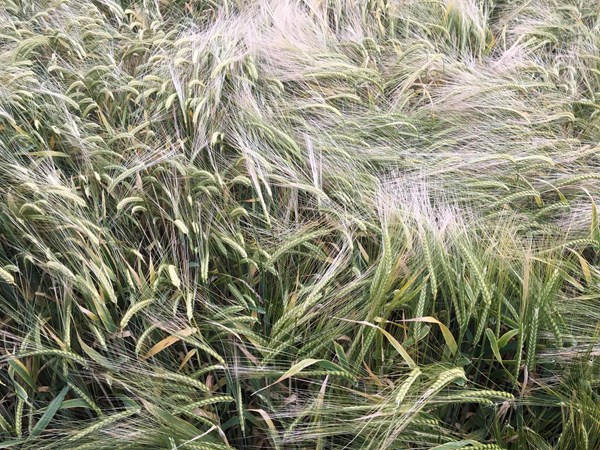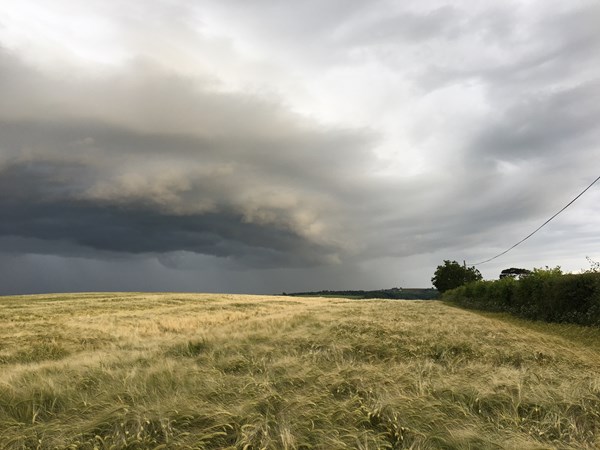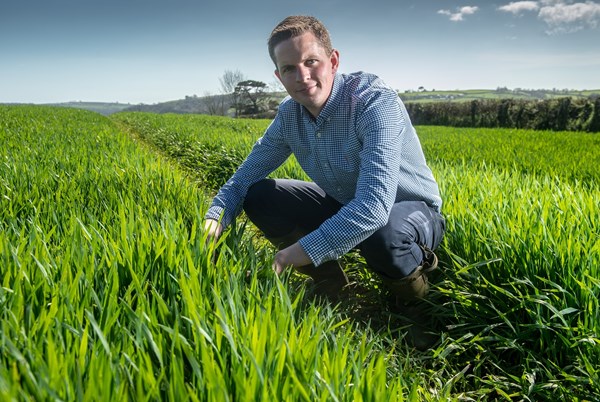- Home
- Projects
- Farm Excellence
- Saltash Monitor Farm
Saltash Monitor Farm
About Saltash Monitor Farm
- Smeaton Farm has been a Monitor Farm since June 2019
- 180ha Duchy tenancy – 100ha arable area with 50 suckler cows and 220 lambing mules
- Arable rotation includes winter wheat, barley and oats as well as spring barley and maize
- Soil types range from medium loam over shillet to clay soils
Ashley Jones runs the mixed 190 ha Smeaton Farm, which is part of the Duchy of Cornwall estate. In partnership with his family, he farms 100 ha cereals with maize and potatoes in the rotation and has 200 head of beef and 200 ewes. Diversification activities on the farm include a bed and breakfast, maize maze, Christmas trees and agricultural contracting.
Saltash Monitor Farm will come to a close in 2023.
Past meetings and updates
Septoria workshop – 12 January 2023
Ashley welcomed Catherine Harries (AHDB Senioer Crop Protection Scientist) and Stephen Kildea (TEAGASC Disease Specialist) on farm. Catherine gave an overview of the latest fungicide performance curves for Septoria and covered various other areas pertaining to septoria control. Stephen Kildea brought a wealth of experience from Ireland’s TEAGASC work on Septoria to add to the conversation.
Find more independent information to aid fungicide decisions here.
Field mapping and variable rate application platforms – 8 Decemeber 2022
Key messages:
- Make sure you can cope with and use the data that system provides
- Make sure you have machinery technology that can use the data to get a return on cost
- Start with the basics – P , K and lime
- Variable rate seeding probably offers the next best return
- Build data over years and use layered recording and monitoring
- Look at all the systems, talk to other users and choose one which you like and you think you will use
Making the most of social media for you and your business – 10 November 2022
The first winter meeting of the 2022 winter season saw Olly Harrison, self-professed ‘accidental YouTuber’, visit Saltash. Olly introduced his own farm and outlined the numerous diversification routes he’s taken in recent years.
Olly then went on to talk about the inception of his YouTube channel, the impact of its success on his business and some of the projects he has been involved in as a result.
Ashley’s update
Ashley trialled 3 drills this year direct drilling cover crops into stubble. He was suitably impressed with the performance of all three and also the take from the cover crops, particularly a rye/vetch mix he tried. Paul Harris of Rothamsted Research estimated that when destroyed, his cover crops would contribute 30 kg/ha N for the following crop.
Overall, Ashley’s crops are looking well however some of his OSR had to be re-drilled in mid-September due to slug damage. Outside of cropping, Ashley reported that his ‘Maize maze’ and pumpkin patch were both successes this year, with the pumpkin patch drawing in 800 visitors each day.
If you would like to be included in the email invite list for future meetings, contact Hannah.Bowden@ahdb.org.uk or alternatively call on 079764 83859.
Getting the best out of your sprays and sprayer – 1 February 2022
Tom Robinson (Tom Robinson Sprays Ltd.) delivered an interactive in-depth operator workshop looking at all aspects of sprays and sprayers.
Reducing inputs: what worked for me? – 4 January 2022
Ashley was joined by Staffordshire farmer Tim Parton. The pair compared and contratsted their farming systems and speculated which techniques employed by Tim could be adopted down in Saltash to farm more profitably and sustainably.
The labour shortage myth – 16 December 2021
Paul Harris discussed the issues of labour supply and management on our farms. Covering recruitment, effective communication, personality styles and how to become an employer of choice.
Soil, root and metal management – 11 March 2020
Philip Wright (Wright Resolutions) outlined principles to keep in mind when selcting tyre pressues and cultivation strategies. The take-home messages were:
- Tyre pressures – the lower the better. Get the right tyres when you purchase the tractor and measure to manage.
- Cultivations - Go out with a spade first. Creep toward more shallow cultivations, the soil needs to 'get ready' before jumping to direct driling.
Labour, power and machinery review – 12 February 2020
A comprehensive study into scale and profitability was undertaken at Saltash.
- To get an accurate picture, Ashley's whole business, not just the arable enterprise, was taken into account
- It was found that Ashley theoretically had the capacity to take on an extra 100ha into his arable rotation – reduction cost of production by £20-£30/t
- However, with labour stretched as it is at peak times the production-cost cuts may not be worth the hassle of expansion
- The same risk-reward conundrum was encountered when looking at increasing chemical inputs – protecting yield may not always warrant the cost of the chemicals
- Spring Barley was found to be expensive in comparison to Ashley’s winter crops
- Machinery replacement was considered as an option for safely improving profitability
The full Labour, Power & Machinery breakdown can be found here: Saltash Monitor Farm Labour & Machinery Review | AHDB
Managing for yield and margin – 18 December 2019
The group explored factors that may limit yield and highlighted practices that can be optimised to reach yield potential without hurting margins. See the meeting report for full details: Saltash Monitor Farm YEN Meeting Report | AHDB
Profitable rotations – 6 November 2019
Sebastian Graff-Baker (Andersons) outlined key considerations for optimising crop rotations, find the take home messages from the meeting in this report: Saltash Monitor Farm Profitable Rotations Meeting | AHDB
Soil Health Scorecard – Autumn 2019
The soil health scorecard provides a framework to monitor soil health on a rotational basis.
It uses soil analysis results for core soil health indicators and compares them to typical ranges for UK soil types and climate regions (benchmarks).
A completed Excel scorecard automatically produces a 'traffic-light' snapshot of soil health to guide management decisions.
In 2019, this Monitor Farm completed a scorecard.
Saltash Monitor Farm soil health scorecard (case study)
Read more soil health scorecard case studies
Ashley already samples his whole farm every four years as part of a SOYL testing scheme and has managed to halve his spend on supplementary P and K as a result of this regular testing.
Sewage sludge and farmyard manure were added to the fields at Smeaton Farm in an attempt to increase soil organic matter levels.
Launch meeting – 10 June 2019
At the Monitor Farm launch meeting, Ashley expressed his goals for the three-year programme:
- Continue to be an active farmer.
- Double the current arable area whilst keeping profit margins.
- Generate extra profit to replace BPS.
- Develop a marketing profile for Smeaton Farm’s contracting services.
- Ensure any newly proposed activities are complimentary to existing practices on the farm.
'PESTLE' analysis highlighted Brexit, market volatility and chemical operation restrictions, as well as others, as challenges to come.
Find full details from the launch meeting, here: Saltash Monitor Farm Launch Meeting | AHDB
+ See more



